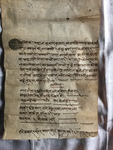A document from General Jagat Śamśera acknowledging having received payment, both in cash and kind, from Pāro Gāũ (VS 1919)
ID: Tsum_0001_0016
Edited and
translated by Nadine Plachta and Rajendra Shakya
Created: 2017-05-08;
Last modified: 2020-07-10
For the metadata of the document, click here
The accompanying edition, translation/synopsis and/or commentary are available under the terms of the Creative Commons Attribution-ShareAlike 4.0 International License
Abstract
This receipt was written by Jagat Śamśera and acknowledges the entry of khānagī revenue into his account.Diplomatic edition
[1r]
[...][Seal of Jagat Śamśera]1स्वस्ति∙श्रीमद्राज∙कुमार∙कुमारात्मजदछिणतर्फकाकम्यां2डींङ∙जनरलश्रीजगत्सम्सेरजङ्गकुव़रराणाकस्यपत्रम्--- ---
3आगेदाषीलाआम्दानीहाम्राजनरलीषान्गीमादरियाकोषु
4व़ाअट्ठारसैषोलामध्ये∙स्यारपट्टीपारोगाउ१को१९५०सा
5लकालोकाभार∙काआम्दानीमध्ये∙मुहुडामाआयाकोमा
6र्फतमुषीया∙छेन्डंडुपहस्तेनीज∙तपसिलवमोजीमकानग
7दजीन्सीहाम्राहजुरदाषीलभयोतस्कोरसिदगरिवक्स्यौ
8वहीवुझ्दामीनाहाहोला∙¯¯¯ ¯¯¯ ¯¯¯ ¯¯¯ ¯¯¯ ¯¯¯
9तपसिल
[table]
| नगदभीत्रढुकुटीदाषीलहस्तेसुवेदार∙सीगवीर∙ मोहरुपैयायेकसैसाढेपंचानवै∙¯¯¯ ¯¯¯ ¯¯¯ ¯¯¯ ¯¯¯ ¯¯¯ ¯¯¯ ¯¯¯ | १९५||∙ | |
| नीजगाउ१को¯¯¯ ¯¯¯ ¯¯¯ ¯¯¯१८४ | भोटकोसीर्ती¯¯¯ ¯¯¯ ¯¯¯११|| |
[table]
| जीन्सी ∙जिम्मारहस्ते∙डीट्ठादयानाथपाध्या¯¯¯ ¯¯¯ ¯¯¯ ¯¯¯ ¯¯¯ ¯¯¯ ¯¯¯ ¯¯¯ | ||
| धन्सार∙दाषील∙नुन्पाथीआठ¯¯¯ ¯¯¯ ¯¯¯ ¯¯¯ ¯¯¯ ¯¯¯ ¯¯¯ ¯¯¯ | |८ | |
| मोरुपैया२कोपाषीथान्¯¯¯ ¯¯¯ ¯¯¯ ¯¯¯ | १ |
18इतिसम्वत्१९१९सालमीतीफागुनसुदी६रोज३शुभ्म्¯¯¯ ¯¯¯ ¯¯¯ [Seal of Śrī Trivikrama][Unknown seal]
Translation
[1r]
[Seal of Jagat Śamśera]
Hail! A letter from the Commanding General of the Southern Front Jagat Śamśera Jaṅga Kũvara Rāṇā, a prince born of a prince
Āge: Of the lokābhāra revenue for the year [VS] 1950 received at the frontier (muhuḍā) 1 , the revenue in cash and kind from our landed emolument (khuvā)—registered as a khānagī of my generalship: 1 village, Pāro (cf. the tapasila below)2 in Syāra3 within the Aṭhāra Saya Kholā region—has been given to us by MukhīyāChen Ḍaṃḍupa4 . A rebate (mināhā) wil be given once the ledgers are received.5
Tapasila
[table]
| Cash entered into the treasury by SubedāraSīga Vīra, mohararupaiyā̃s one hundred ninety-five and a half | 195 mohararupaiyā̃s 2 sukās | ||
| Of the said 1 village --- 184 mohararupaiyā̃s | Sīrtī of Bhoṭa6 --- 11 mohararupaiyā̃s two sukās | ||
| Jīnsī under ḌiṭṭhāDayā Nātha Pādhyā's responsibility [to be collected] and received from him--- | |||
| Entry in the ration godown (dhansāra) - eight pāthīs of salt --- | | 8 | ||
| Entry of a thick woollen rug (pākhī) worth 2 mohararupaiyā̃s--- | 1 piece | ||
Tuesday, the 6th of the bright fortnight of Phālguna in the [Vikrama] era year 1919 [1863 CE]. Auspiciousness.
[Seal of Śrī Trivikrama][Unknown seal]Commentary
The Commanding General of the Southern Front was the fifth brother of Jaṅga Bahādura in the Rāṇā Roll of Succession to the coveted post of prime minister. His title was abbreviated as "Da.Ka.Ja." (Nep. dakṣiṇa tarphakā kamyaṃḍiṅga janarala). There were three other commanding generalships. The eastern and northern posts were exclusively reserved for the fourth and sixth brothers respectively. The western region was looked after by the commanding general of the western front, who, being the de facto head of the army, was also known as Jaṅgī Lāṭha. He served in addition as the head of the Jaṅgī Aḍḍā. As the western force constituted the bulk of the Nepalese Army, he was senior to the other commanding generals (Agrawal 1976: 33).
During the Rāṇā regime, three significant changes were made to the general structure of the judiciary, of which the first (1846-1901 CE), during the time this document was written, made provisions for a total of four gaũḍās: While Pālpā, Dhanakuṭā and Ḍoṭī were three separate gaũḍās, such districts as Bhaktapur, Patan, Gorkha, Dolakha, Jaleśvara, Rauṭahaṭa, Bārā and Chitwan were subsumed under a fourth one, the Ilāmagaũḍā (Vaidya and Manandhar, 2053: 216). It is not clear which of these four gaũḍās was responsible for handling cases in the Aṭhāra Saya Kholā region. Two other documents (Tsum_0001_0008, Tsum_0001_0032), however, relate that a couple of security officials from the Patan Tahabila were sent to Aṭhāra Saya Kholā in order to collect a penalty exacted upon the five ghansum of Pācapārvā, suggesting that Aṭhāra Saya Kholā was under the jurisdiction of the district of Patan.

